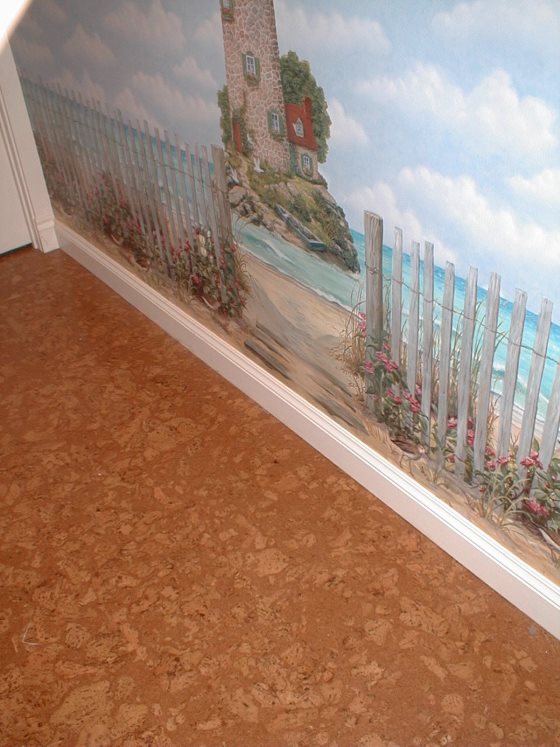Adhesive Remover

The adhesive under this cork flooring is thin and impossible to scrape up without some type of liquid adhesive remover.
DEAR TIM: I recently removed some old plastic wall tile and floor tiles. There is a rock hard layer of adhesive that needs to come off before I can install new flooring and wall coverings. What is the best way to chip off this hard material? I struggled to remove the floor tile. Is there a trick to removing vinyl floor tiles? Veronica M., Atlanta, GA
DEAR VERONICA: Wow! Now here are two jobs I would make excuses for all day long. The thought of doing both projects back to back is true mental anguish. There are some tricks I have discovered that will make the jobs progress somewhat faster. The good news is that the hard adhesive residue can almost always be softened and disposed of.
Adhesive removal can be a chore. The primary reason is that there are so many different types of adhesives. Reversing the chemistry to make the rock hard deposits soft again can only be accomplished by using the correct adhesive remover. Fortunately, there are many superior products that are readily available. What's more, many are job specific. The product label frequently describes exactly what they will do.
Adhesive removers are very closely related to paint strippers. The reason is very simple: paint is simply a colored glue. Many of the companies that produce paint strippers manufacture adhesive removers. The products soak into the adhesive transforming it back to the paste or liquid state. Once it is softened, you can usually remove it with a hand scraper.
The most user-friendly adhesive removers are made with citric acid technology. Look for the word "citrus" in the label and be assured the product will be fairly easy to use. These products often are water washable and are low-odor. Some are liquid and others are a paste. You simply apply them to the hard adhesive, stand back and let them work. The paste products work best on vertical surfaces.
Another user friendly product is a soy-based adhesive remover. This product softens a wide range of old adhesives. It also rinses off with water. Keep in mind that these products often have a dwell time of several hours. This means that you apply them and wait for them to soften the glue. The product labeling usually gives you a good idea of the minimum dwell time. If you get impatient and try to remove the adhesive before the remover has had sufficient time to work, you will just add to your workload. Let the remover soften the hard adhesive completely, before you start to scrape.
Pay attention to recommendations regarding sunlight and wind. Direct sunlight and wind can evaporate the products. If you apply certain adhesive removers and neglect to follow instructions, the adhesive may get soft and then re-harden before you have a chance to remove it. It is a wise idea to try a small test section to get a feel for how quickly the adhesive remover works.
Tough adhesives sometimes require a solvent based adhesive remover. These products are more toxic than the water based adhesive removers. Pay very close attention to all label warnings. These products are often highly flammable and the fumes can be very dangerous to inhale for a period of time. Work in a well ventilated space.
The adhesive removers can be found in many hardware stores and large paint stores. The Internet is also a good place to shop for specialized adhesive removers for unique projects. Keep in mind that most of the paint stripper manufacturers also have a companion adhesive remover line. A particular store may be able to order the product if it is not a stock item.
Several years ago, I read about a technique to remove vinyl floor tile one piece at a time without breaking the tiles. All you need is a block of dry ice. Slide the dry ice over a tile and within a few seconds it will contract just enough to release itself from the adhesive bond. Frequently, you will hear the tile "pop" loose. You move the ice block to the next tile and pick up the full tile that is now floating free above the adhesive layer.
If you decide to try this method, be aware of certain dangers. The dry ice is simply solid carbon dioxide. You must ventilate the space you are working in very well to dissipate the gas. Failure to do this can cause serious injury or death. The carbon dioxide can also kill any animals that might be nearby. As long as you can open some windows and bring in outdoor air, you should be fine. Wear thick gloves as well. The dry ice can cause instantaneous frostbite if it touches exposed skin.
Column 421
One Response to Adhesive Remover